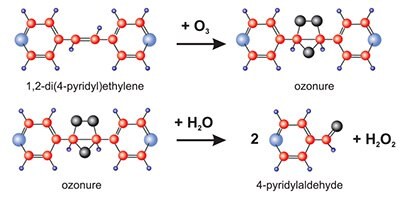radiello® Diffusive Air Sampling Application - Ozone
radiello® Components Used:
Blue diffusive® body Product No. RAD1201
Supporting plate Product No. RAD121
Vertical adapter Product No. RAD122 (optional)
Chemiadsorbing cartridge Product No. RAD172
Principle
The adsorbing cartridge is formed by a micropore polyethylene tube filled with silica gel coated with 4,4’-dipyridylethylene and closed, at one end, by a PTFE cap. Upon exposure, acid-catalysed ozonolysis of 4,4’-dipyridylethylene leads to 4-pyridylaldehyde.

Silica gel ensures the presence of water, necessary to complete ozonolysis reactions.
In the laboratory, 4-pyridylaldheyde is condensed with 3-methyl-2-benzothiazolinone hydrazone (MTBH) to yield the corresponding azide, yellow colored. The absorbance of the solution is measured at 430 nm. Production of 4-pyridylaldehyde is a specific reaction of ozone; neither nitrogen oxides nor organic compounds, if present, do interfere.

Sampling Rate
The sampling rate value Q at 298 K (25 °C) and 1013 hPa is 24.6 mL·min-1.
Sampling is linear in the exposure range from 10,000 to 4,000,000 μg·m-3·min-1.
Effect of Temperature, Humidity, and Wind Speed
Sampling rate varies from the value at 298 K on the effect of temperature (in Kelvin) as expressed by the following equation:

where QK is the sampling rate at the temperature K and Q298 is the reference value at 298 K.
Sampling rate is not influenced by humidity or wind speed.
Calculations
The average concentration over the whole exposure time is calculated according to the equation:

where m is ozone mass in μg sampled by radiello and t is exposure time in minutes.
Exposure
Introduce the cartridge in the diffusive body and make sure that the PTFE cap is positioned at the same end of the screw.
In outdoor environments, where typical ozone concentrations range from 2 to 400 μg·m-3, we suggest exposure time from 24 hours to 14 days. The ideal range is from 3 to 7 days.
In workplace environments it is advisable to sample over the entire 8 hours shift.
Limit Of Detection and Uncertainty
The limit of detection is 2 μg·m-3 for 7 days exposures. The cartridge is saturated after 14 days exposure at 400 μg·m-3.
The uncertainty at 2σ is 14.5% over the whole sampling rate linearity range.
Storage
The cartridges need only protection from direct sunlight: keep them in a drawer or a cupboard at room temperature. In these conditions, the blank level does not exceed 0.015 absorbance units for up to six months.
Expiration date is printed onto the plastic bag wrapping each cartridge.
Generally, an increase of blank level does not imply that the cartridge must be discarded. The only consequence is a corresponding increase of the analytical limit of quantification.
After exposure the samples have to be stored in the dark as before, along with three unused cartridges to be analysed as blanks. Analyse them within a week.
Analysis
Reactives and Materials
- 3-methyl-2-benzothiazolinone hydrazone hydrocloride (MBTH): dissolve 5 g per liter in water and add 5 mL of concentrated sulphuric acid; this solution is to be freshly prepared.
- 4-pyridylaldehyde
- micropore filter membrane 0.45 μm
Procedure
Draw the cartridge out from the plastic tube, discard the PTFE cap and pour the silica gel into the tube. Add 5 mL of MBTH solution, recap the tube and stir vigorously. Let the tube stand for at least one hour to react, stirring from time to time. Filter through the micropore filter (if you make use of RAD174, act as follows: fit the filter to the syringe, transfer the solution from the tube to the syringe and filter it into a second tube or directly into the spectrophotometer measure cell).
Measure absorbance at 430 nm using water to zero the spectrophotometer. The yellow color is stable for several days if the solution is kept well capped in its tube.
Treat in the same manner three unused cartridges of the same lot and subtract the average blank value from the absorbance values of the samples.
IMPORTANT
If the absorbance value is higher than the calibration curve upper limit dilute the sample with the MBTH solution: never use water to dilute! Water alters the pH of the solution with unpredictable variations in the linearity of absorbance values vs concentration.
USER TIP
For a simple and accurate filtration make use of the filtration kit Product No. RAD174.
Calibration
Dissolve 100 μL (112.2 mg at 20 °C) of 4-pyridylaldehyde in 1 liter of water and dilute this solution (e.g. 1:2, 1:5, 1:10) to obtain calibration solutions. Transfer 0.5 mL of each calibration solution in a plastic tube together with 4.5mL of MTBH solution. Stir and let stand for one hour, then read the absorbance at 430 nm (filtration is not needed). Plot the calibration curve for ozone mass vs measured absorbance, taking into account that:
1 μg of 4-pyridylaldehyde = 0.224 μg of ozone.
To continue reading please sign in or create an account.
Don't Have An Account?